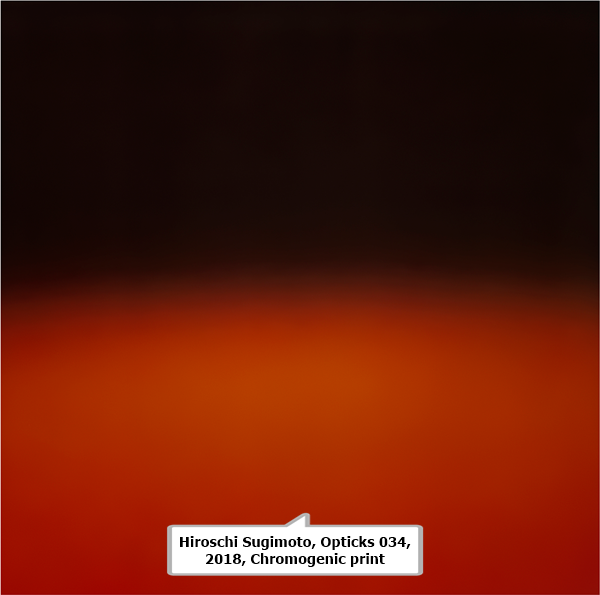"Theory of Colours "
20 March > 22 May, 2021 QR of this press release
Hiroshi Sugimoto

Marian Goodman Gallery
79 rue du Temple 75003 Paris
![]()
Telephone: 33-1-48-04-7052 e-mail:
Multiple location : Paris New York Londonl




—Hiroshi Sugimoto
Galerie Marian Goodman is delighted to present Theory of Colours, the third solo exhibition by Hiroshi
Sugimoto in Paris. The exhibition will focus on his new body of work, Opticks.
Opticks, 2018, was created by capturing the photographic transcription of colors as revealed when light passes
through an optical glass prism.
The title of this series is a reference to Sir Isaac Newton’s treatise Opticks, published in 1704. Preserved on
Polaroid film, the colors of each photograph convey not only Sugimoto’s interest in the most subtle hues of the
rainbow, but also those colors which embody a transition, which appear to be mixed or hard to define. Sugimoto
writes:
Gazing at the bright prismatic light each day, I too had my doubts about Newton’s seven-colour
spectrum: yes, I could see his red-orange-yellow-green-blue-indigo-violet scheme, but I could just as
easily discern many more different colours in-between, nameless hues of red-to-orange and yellow-togreen.
Sugimoto is not only a reader of Newton, but also of Johann Wolfgang von Goethe. In his Treaty of Colours (Zur
Farbenlehre), published in 1810, Goethe described optical phenomena from a more sensitive point of view,
prompting Sugimoto to develop a poetical and metaphysical perception of color “with neither Newton’s
impassionate arithmetic gaze, nor Goethe’s warm reflexivity, I employed my own photographic devices toward a
Middle Way.” Thus, the artist reminds us that in East Asian Buddhist doctrines, the word ‘color’ refers to the
materialistic world, while its Japanese transcription both signifies ‘emptiness’ and ‘sky.’ “To sum it up,” cites
Sugimoto, “if the visible world of colour is essentially empty, then this world is as immaterial as the colour of the
sky.”
Sugimoto often works in synergy with arbitrary environmental data making each exposure unique:
My daily routine saw me rise at 5:30 every morning. First thing, I would check for hints of light dawning
above the eastern horizon. If the day promised fair weather, next I would sight the ‘morning star’ shining
to the upper right of the nascent dawn. Depending on how bright Venus appeared, I could judge the
clarity of the air that day- (…). Only then did I ready my old Polaroid camera and start warming up a film
pack from the long winter night chill.
In his studio in Tokyo, designed as an observational space, Sugimoto uses a device equipped with a prism
through which the light passes. When the color spectrum hits a surface at an angle, its continuum can be
decompressed, facilitating a complete exploration of a particular hue. “I could split red into an infinity of reds.
Especially when juxtaposed against the dark, each red appears wondrous unto itself. Moreover, colours change
constantly.”
The phenomenon of retinal persistence tells us that, after staring at a single color, we will see an afterimage of
the opposite color for a few seconds when we glance away. This experience inspired Sugimoto to explore
emptiness and the contradictions of color: “…look too long at this world and we see an inverted world. It makes
me think all the more that ‘form is emptiness’ and vice-versa.”
In the crypt, there will be a screening of The Garden of Time, a film produced by the Mori Art Museum and
Odawara Art Foundation, featuring renowned dancers Aurélie Dupont and Min Tanaka. The film also features
a text by Sugimoto, offering insight into the details behind Odawara’s Enoura Observatory.
The Odawara Art Foundation was established in 2009 in order to foster the advancement of Japanese culture
while adopting an international perspective, by producing and promoting theater, from classical theater arts to
avant-garde stage art. The site of The Enoura Observatory designed by Hiroshi Sugimoto opened to the public
and visitors in October 2017.
The beautiful catalogue, Hiroshi Sugimoto: Post Vitam, published in April 2020 on the occasion of his exhibition
at the Kyoto City Kyocera Museum of Art, will be for sale exclusively at our bookshop. In addition, the bookshop
will be offering two other publications by Sugimoto: Snow White, a luxurious publication of 400 copies, signed
and numbered, devoted to his ‘Theaters Series’; Hiroshi Sugimoto: Seascapes, published by Xavier Barral.
Hiroshi Sugimoto was born in Japan in 1948. Since the 1970s, he worked primarily in photography, eventually
adding performing arts production and architecture to his multidisciplinary practice. His work investigates
themes of time, empiricism and metaphysics. Sugimoto’s work is held in the collections of the Metropolitan
Museum of Art, New York; Museum of Modern Art, New York; National Gallery of Art, Washington, DC; San
Francisco Museum of Modern Art; and Tate Gallery, London; among many others. His work has been the subject
of numerous monographs. Sugimoto is the recipient of the National Arts Club Medal of Honor in Photography;
The Royal Photographic Society’s Centenary Medal; Isamu Noguchi Award; Officier de L'ordre des Arts et des
Lettres; Praemium Imperiale Award for Painting; PhotoEspaña Prize; and the Hasselblad Foundation
International Award in Photography, among others.

Hiroshi Sugimoto
mpefm
FRANCE art press release
To protect our visitors and staff, and mitigate exposure to COVID-19, appointments are mandatory, face coverings are required for entry and must be worn at all times. Visitors must maintain proper social distance and be mindful of the allotted time.
Tuesday - Saturday, 11 am - 5 pm
Book an appointment.
in your phone, tablet
Marian Goodman Gallery, Paris FRANCE - Hiroshi Sugimoto : Theory of Colours - 20 March > 22 May, 2021 @MarianGoodman
Does not art serve to retrieve what falls through the cracks, now that scientific knowledge no longer
needs a God?







